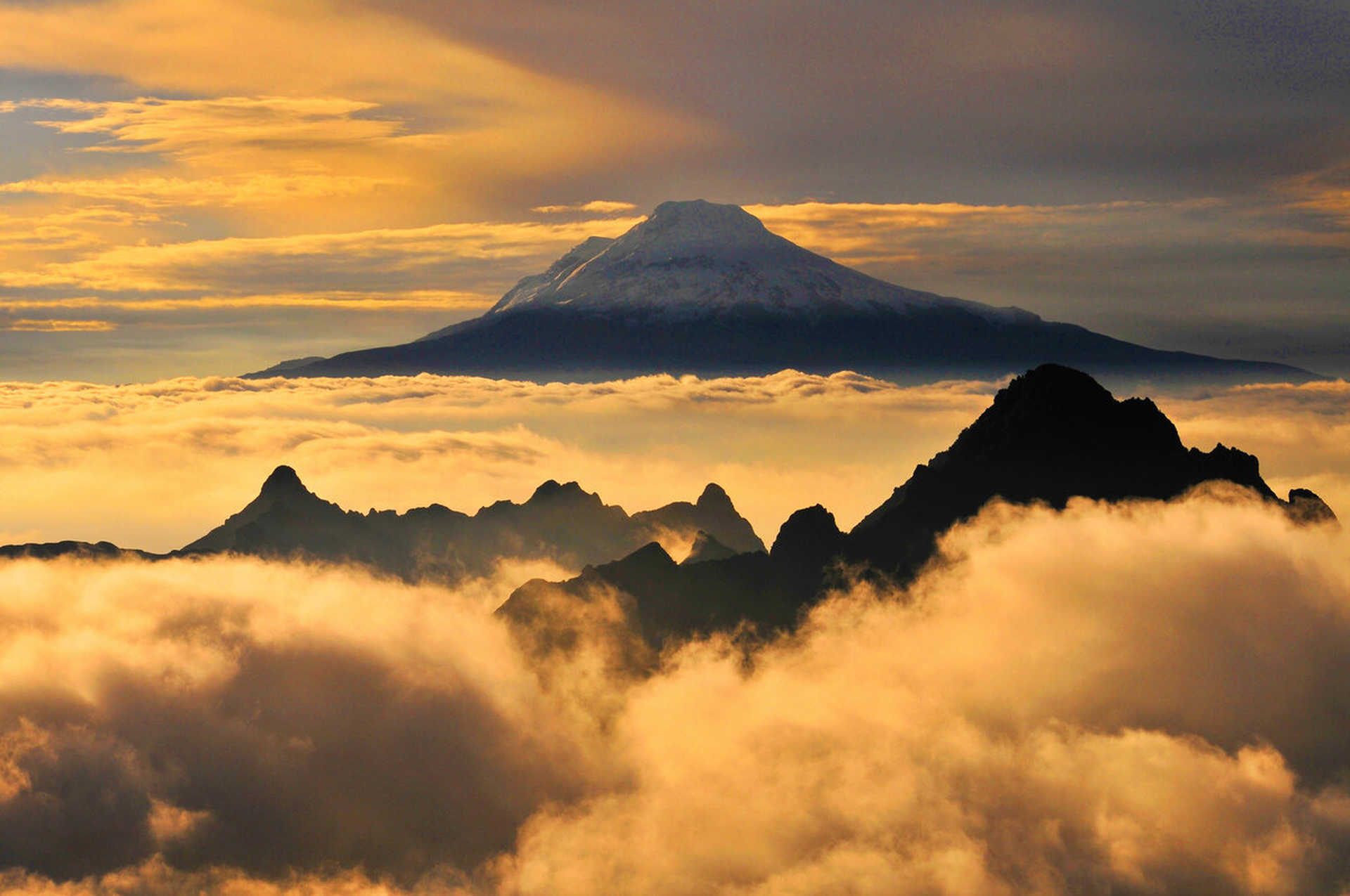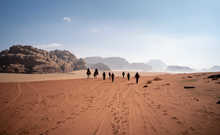Ecuador Volcanic Adventures
- Kandoo Trekking

Contact
our UK team

Welcome to Quito! Declared a UNESCO World Heritage Site in 1978, the city is considered the cultural capital of South America and is located on the equator in a valley at the foothills of the Pichincha volcano. Depending on our arrival time, we can spend today exploring the old town of Quito and the surrounding area. In the evening, one of our trip leaders will meet us at the hotel’s lobby for a welcome briefing at 6pm. This is a time to ask any questions we may have regarding our upcoming adventure.
Explore a truly unique experience in the heart of Quito city and discover it's history from the eyes of the locals, walking around it's narrow streets and visiting the iconic, architectural buildings of the Golden Church, San Francisco Square and the Main Square. We then attend Luis´ local workshop “Cruz Verde”. Luis is a well know artisan whose family has prepared the local candy “Colaciones” for the last 100 years, keeping alive Quito´s timeless tradition. For lunch, we will have the opportunity to sit with the locals and enjoy a tasty meal, freshly prepared using local products and flavours.
The mountainous Andean landscapes provide inspiration today as we head out on a trek along the steep sided Toachi canyon. With stunning vistas of the small villages dotted along the riverside and indigenous people working in the fields, we are well and truly thrown into the depths of rural Ecuador. We hike down the canyon alongside the Toachi River until we reach the road that will take us to Chugchilán, a small town located in the middle of the Quilotoa loop. Here we will find our accommodation for the evening, a quaint eco-house nestled in the countryside. We have some time to explore the village and meet the friendly locals before dinner.
Early this morning, after breakfast, we begin our hiking adventure on small trails carved out by locals to transport goods across the canyons to reach neighbouring communities. While trekking on this trail, it is common to see residents of the area bartering with one another, a traditional that is still holding strong. We venture down into impressive narrows canyons, then climb up to the top of the crater rim, where we are rewarded with spectacular views of Quilotoa Lake. The majestic beauty of this place is arresting.
We enjoy a very scenic picnic with views from the volcano, out across the surrounding rolling landscape, before hopping into our vehicle and transferring to our hacienda in the foothills of Chimborazo volcano.
This morning, we will drive through valleys and farming villages to reach the Chimborazo Volcano, the highest mountain in Ecuador with an elevation of 6310m; whose summit is the furthest point from the center of the earth on the entire planet! On a clear day, the majestic peak of Chimborazo dominates the view for miles around. Once in this spectacular national park, we embark on a short but steep hike of around 1km to reach the snowline where the glacier begins. On the hike, we keep our eyes peeled for some of the animals that inhabit this volcanic climate; broad winged Andean condor, delicate hummingbirds and timid wild Vicuñas to name a few. Once extinct in Ecuador, Vicuñas were reintroduced into the wild and are now protected. It isn't hard to tell that this beautiful animal is related to alpacas and llamas. We indulge in a delicious picnic at the base camp before returning back down the way we came.
The Llanganates National Park, famous for its legendary folk tales of hidden treasure, buried away by the Inca General Ruminahui, provides us with some of the iconic, volcanic, Ecuadorian landscapes that have led us to adventure here. Starting our hike at 3,200m we climb steadily upwards to 3,600m through a variety of changes in vegetation. If visibility is good, expect stunning views of the Tungurahua and Sangay volcanoes as we weave our way through the web of tiny valleys, carved into the mountains by torrenting rivers. After this beautiful trek, we return to Baños where we can spend our evening soaking in the famous hot springs of Baños and experience the thriving nightlife of this town.
This morning we transfer to Cotopaxi National Park where we head out hiking in the Sierra climate around the Limpiopungo lagoon on the foothills of Rumiñahui volcano. From here, we have the unrivalled views of the triangular peak of Cotopaxi, the highest active volcano in the world. Along the trail we may catch glimpses of wild horses, ox, and some beautiful bird species. We then conclude our day driving to Isinlivi, where we will spend the night.
We begin today with a leisurely morning, to prepare ourselves for our attempt of Cotopaxi summit (5897m). We pack our bags ready for our two-day push and have lunch at a local restaurant, before transferring to the entrance of Cotopaxi National Park. From here, we will head east to where the trail begins (4864m) and then leaving the vehicle here, we will hike for about an hour to reach the José Ribas Refuge (4862 m). Finding our beds for the night, we will have dinner, make sure our bags are packed and get an early night ready for our midnight wake up call.
At midnight, we will get up and have a snack to give us some energy before starting our climb. We will set off traversing the ochre coloured scree slopes to reach the glacier where we will be roped together to stay safe as we cross snow bridges and climb steep sections. From the summit we have a marvellous view of the icy rim of Cotopaxi's crater, with an 800m diameter, this cavernous basin boasts breathtaking views of the surrounding volcanoes and peaks. Returning to the refuge around midday, we have some lunch before being transferred back to Quito.
Today we are wished a “buen viaje” and transferred to the airport for our onwards flights.
This trip is given a challenging rating because it has some fairly tough elements incorporated into it. Cotopaxi is the most accessible and therefore most popular peak to summit in Ecuador, however this is not to say its an easy ride. You will be walking on glacial terrain, crossing snow bridges and moving between crevasses which makes this a proper challenge! Sitting at 5897m above sea level, you will also feel the effects of altitude at this height. However, for those who have already completed a high altitude peak such as Kilimanjaro, this trip provides an excellent challenge to try out your first attempt at winter mountaineering in a similar environment.
In Ecuador, expect to try a whole host of exotic foods and spices as we travel through various different regions. From the traditional foods of toasted corn and stuffed meats, to the more trendy spicy empanadas and citrus-infused cerviche the cuisine here is delicious! The guesthouses and smaller hotels we stay in will provide hearty, generous meals and in the larger cities you will have the choice of local restaurants or hotel favourites. Drinks are not included with dinner, so please make sure you have some cash with you for any drinks you may want. Please also be aware that hotels in small villages and town may not accept card payments.
Water in Ecuador isn't necessarily safe to drink. We provide
water bottle refills every morning and evening from a filtered water source, if
you think you will need to refill your bottle during the day, we suggest you
bring a water purification system. We do not encourage the purchase of
single use plastic bottles so we would recommend either a charcoal filter or
purification tablets to make your water safe to drink.
On this trip we will stay in a range of accommodation. For some of the nights in the valleys between mountain days we will be staying in family run guesthouses, know locally as Hosteria. These are small, simple hotels with basic twin or double rooms. Most of the guesthouses we use have en-suite rooms however, dependant on the location, some have shared bathrooms. In Quito, we will be staying in a comfortable 4* hotel in en-suite rooms on a twin share basis. Single rooms are also available on request for all nights on this trip.
Your bags will be transported by vehicle between locations,
and you will carry a smaller 30-40L daysack on your treks each day.
For US travellers, there are direct flights to Mariscal Sucre airport with American Airlines, LATAM and Delta from Miami and Atlanta. They also offer services from other main hubs such as New York, San Francisco and Dallas, via Miami. Copa Airlines also offer a service to Quito via Panama from San Francisco and Los Angeles.
Guides: US$10 – 20 per trekker
per day
Drivers: US$5 – 10 per trekker
per day
Specialist mountain guides: US$50
per person per climb
Specialist mountain guides will join you for the climbs. Any tip made to them should
be made after your climb as you will leave them after the climb has ended.
Tips should be made in US Dollars
and bills should be crisp, untorn and less than 10 years old.
For this trip you will need specialist climbing equipment. We provide the following equipment as part of your trip package. This equipment is regularly checked and updated to meet regulations.
UPPER BODY
LEGS
FEET
CLIMBING GEAR
OTHER ACCESSORIES
| From | To | Price | Availability | Book | Enquire |
|---|---|---|---|---|---|
| 07/02/2026 | 16/02/2026 | £1,999 $2,599 |
Available
|
Book now | Enquire now |
| 06/06/2026 | 15/06/2026 | £1,999 $2,599 |
Available
|
Book now | Enquire now |
| 18/07/2026 | 27/07/2026 | £1,999 $2,599 |
Available
|
Book now | Enquire now |
| 02/01/2027 | 11/01/2027 | £2,099 $2,729 |
Available
|
Book now | Enquire now |
| 06/02/2027 | 15/02/2027 | £2,099 $2,729 |
Available
|
Book now | Enquire now |
| 05/06/2027 | 14/06/2027 | £2,099 $2,729 |
Available
|
Book now | Enquire now |
| 17/07/2027 | 26/07/2027 | £2,099 $2,729 |
Available
|
Book now | Enquire now |
Want to ask us a question or book a private trip? Don't hesitate to contact us!
Contact us